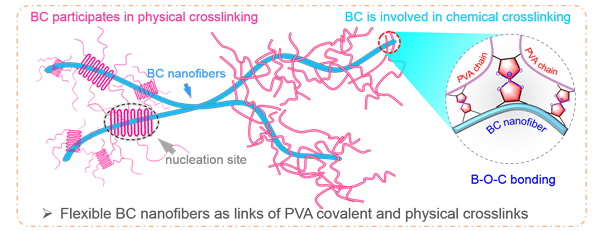Using Bacterial Cellulose to Bridge Covalent and Physical Crosslinks in Hydrogels for Fabricating Multimodal Sensors
作者:Chenguang Jiang, Yuchen Chao, Wenyuan Xie*, Defeng Wu*
关键字:bacterial cellulose; hydrogels; dual crosslinks.
论文来源:期刊
具体来源:International Journal of Biological Macromolecules
发表时间:2024年
International Journal of Biological Macromolecules, 2024, 263, 130178. (highly cited paper)

Optimization of networks is vital for the hydrogels with multiple crosslinks. In this work, we proposed a ‘two-step’ strategy to activate synergistic effect of covalent and physical crosslinks using poly(vinyl alcohol)(PVA)/bacterial cellulose (BC) hydrogel as template. The BC nanofibers, on the one hand, acted as nucleating agents of PVA, participating in the construction of PVA crystalline networks, and on the other hand, were involved in the boronic ester bonding, anchored with the PVA covalent networks. Thus, the presence of flexible BC networks, as ‘bridge’, linked the crystalline regions and amorphous domains of PVA together, associating the two characteristic crosslinks well in hydrogels. The overall mechanical properties, including tensile elongation and strength, as well as fracture toughness, were highly improved. As-prepared hydrogels possessed good ionic conductivity, which was sensitive to the tensile deformation and environmental temperature, thereby could be well applied as flexible strain sensor and thermal receptor. This work defines an interesting role of BC nanofibers in hydrogels and also provides an effective way of optimizing network structures for nanocellulose reinforced PVA hydrogels.
PDF DOWNLOAD:
https://www.sciencedirect.com/science/article/pii/S0141813024009814
